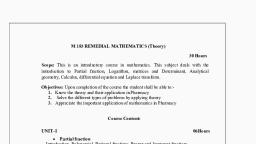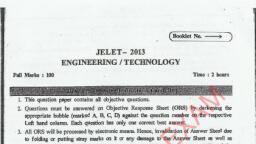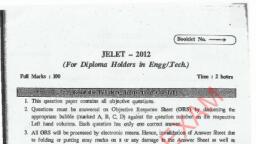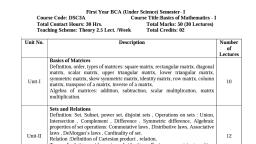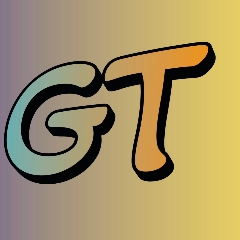Page 1 :
West Bengal Joint Entrance Examinations Board, AQ - 13/1, Sector - V, Salt Lake City, Kolkata – 700091, Help Desk: 1800-1023-781, 1800-3450-050 (Toll Free), Dated, 16th November 2021, , Notice – Pattern of Question Paper of JELET-2022, 2.0, , JELET-2022, , 2.1, , The Examination: WBJEEB will conduct OMR based Common Entrance Examination, (JELET-2022) for admission into 2nd year (3rd semester) of four-year bachelor’s, degree courses in Engineering/ Technology/ Pharmacy (except Architecture) in, Universities, Government Colleges as well as Self Financing Engineering &, Technological Institutes in the State of West Bengal for the academic session 2022-23., , 2.2, , Schedule of JELET-2022: The common entrance test will be conducted on 14th May, 2022 (Saturday) from 11:00 AM to 1:00 PM. (tentative)., JELET-2022 will be held once only and there shall be no further examination under any, circumstances for those who are unable to appear on the above date and time., , 2.3, , Pattern of Question Papers., , A. At the time of online application, candidates will select his/her qualifying, examination among, i. Diploma in Engineering/Technology, ii. Diploma in Pharmacy, iii. BSc, , B. There will be two separate papers namely,, i., , Paper-I for Diploma in Engineering/Technology OR BSc candidates., , ii., , Paper-II for Diploma in Pharmacy candidates., , C. The paper for Diploma in Engineering/Technology OR BSc candidates will have the, following structure., Diploma in, Engineering/Technology, OR BSc, Topics, Mathematics, Physics, Chemistry, , Category-1, , Category-2, , Full Marks, of each Q = 1, No. of, Questions, 30, 25, 15, , Full Marks, of each Q = 2, No. of, Questions, 10, 5, 5, , Total, Number of, Questions, , Total, Marks, , 40, 30, 20, , 50, 35, 25
Page 2 :
Fundamentals of, Electrical & Electronics, Engineering, , 10, , -, , Total, , 10, , 10, , 100, , 120, , D. The paper for Diploma in Pharmacy candidates will have 100 questions of, Category-1., , E. All questions will be of Multiple- Choice Question (MCQ) type, with four, answer options. Time for the paper is 2 hours. The questions will be in English, language only, 2.4, , Syllabus: See appendix., , 2.5, , Scoring Methodology, a. Category 1:, Only one option is correct., Correct option will yield 1 (one) mark, Incorrect option will yield -¼ (negative ¼) marks., For any combination of more than one option, even if it contains the correct, option, the said answer will be treated as incorrect and will yield -¼ (negative, ¼) marks., Not attempting the question will fetch 0 marks., b. Category 2:, , , One or more options are correct., , , , Marking all correct options only will yield 2 (two) marks., , , , For any combination of answers containing one or more incorrect options, the, said answer will be treated as incorrect, and it will yield zero (0) mark even if, one or more of the chosen options is/are correct., , , , For partially correct answers, i.e., when all correct options are not marked and, also no incorrect options are marked, marks awarded = 2 X (no of correct, options marked) / (total no of actually correct options), , , , Not attempting the question will fetch 0 marks
Page 3 :
JELET syllabus 2022, Mathematics (JELET), A. Matrices up to order 3:, Definition of Matrix and its order. Different types of Matrices. (Rectangular, square, row, column,, upper triangular, lower triangular, diagonal, scalar, identity, null). Equality of two matrices., Addition, subtraction, multiplication of a matrix by a scalar and multiplication of two matrices., Transpose of a matrix, symmetric and skew symmetric matrices, simple problems. Singular and, non-singular matrices, adjoint and inverse of a matrix of order 3., Eigen Values of matrix up to order 3. Statement of Cauchy Hamilton Theorem and application for, determining inverse of matrix. Diagonalization of matrices., B. Determinant up to order 3:, Definition and expansion of determinants of order 2 and 3. Minor and cofactors. Elementary, properties of Determinants (statements only) and simple problems. Solutions of linear, simultaneous equations (up to 3 unknowns) by Cramer’s Rule., Rank of a matrix up to order 3. Linear homogeneous and non-homogeneous system of equations, – statements of the relevant results and its applications., C. Complex Number:, Definition of complex numbers, Cartesian and polar. Exponential form of complex numbers., Modulus, amplitude and conjugate of a complex number. Algebra of complex numbers (Equality,, Addition, Subtraction, Multiplication). Cube roots of unity and its properties. De Moivre’s theorem, (statements only) and simple problems., D. Co-ordinate Geometry(2D):, Concept of polar co-ordinates and its relation to Cartesian co-ordinates. Conic section in 2D –, Definition, simple properties, Tangents and Normal., E. Vector Algebra:, Definition of a vector quantity. Concept of Position vector and Ratio formula. Rectangular, resolution of a vector. Algebra of vectors – equality, addition, subtraction, and scalar, multiplication. Scalar (Dot) product of two vectors of with properties. Vector (cross) product of, two vectors with properties. Applications: Application of dot product in work done by a force and, projection of one vector upon another, application of cross product in finding vector area and, moment of a force., Scalar and vector triple product and their geometrical interpretations. Linear combination of 3, vectors. Linear dependence and independence of vectors., F. Differential Calculus:, Concept of function of one variable – Domain and range. Type of different functions including, periodic functions. Limit and continuity. Standard limits. Types of discontinuity. Derivative of a, functions (1st order and 2nd order). Statements and Applications of Roll’s Theorem, Mean Value, Theorem. Indeterminant Form. L’Hospital’s rule., G. Application of Derivative:
Page 4 :
Geometric meaning of derivative. Rate measurement. Maxima and Minima (one variable), , H. Partial Differentiation:, Definition and meaning of partial derivative. Evalution of partial derivatives. Definition and, examples of homogeneous functions. Euler’s theorem (1st order) on homogeneous functions for, 2 variables (without proof). Problems., I., , Integral Calculus:, , Definition of Integration as inverse process of differentiation. Rules for integration (sum,, difference, scalar multiple). Integration of standard functions. Integration by substitution., Integration by parts. Integration by partial fraction., Definition of definite integral and simple problems. Properties of definite integral with simple, problems. Application of definite integral – area of bounded region., J., , Ordinary Differential Equation:, , Definition of ordinary differential equation, order and degree. Solution of differential equation of, first order and first degree. Separation of variables. Homogeneous type. Exact type. Linear type., Solution of differential equation of first order but not of the first degree. Solution of linear second, order differential equation with constant coefficients. Complementary Functions (C.F). Particular, integral for polynomial function eax, sinax and cosax, [F(-a2)≠0] eaxV where V is a function. Simple, problem., K. Probability:, Definition of random experiment, sample space, event, occurrence of events and types of events, (e.g., Impossible, mutually exclusive, Exhaustive, Equally likely). Classical definition of, probability, simple problems. Statements of total probability, compound probability and Base’s, Theorem and simple problems.
Page 5 :
Physics (JELET), A. Units, dimension, and measurement: CGS, MKS, SI units. Dimensions of common physical, quantities, dimensional analysis. Common errors in measurement. Error, accuracy, precision,, resolution, significant figure., , B. Kinematics: Speed, velocity, acceleration, uniform/non-uniform, rectilinear/ circular, motion. Position/ velocity-time graph. Resolution and composition of vectors, scalar, multiplication of vectors., , C. Laws of motion: Newton’s laws of motion. Force, momentum, inertia, moment of inertia,, impulse, couples, moment. Conditions of equilibrium. Conservation of momentum., Centripetal and centrifugal forces. Angular displacement/ velocity/ acceleration/, momentum, torque. Static and dynamic friction, angle of repose, banking of roads., , D. Work, power, energy: Definition, measures, and units. Law of conservation of energy. Kinetic, and potential energy., , E. Gravitation: The universal law of gravitation. Acceleration due to gravity and its variation, on/ above/ below Earth’s surface. Gravitational potential energy. Vertical linear/ vertical, circular/ projectile motion., , F. Elasticity: Deforming force and restoring force, elastic, and plastic body. Stress-strain, relationship, Hook’s law, Young’s modulus, Bulk modulus, Rigidity modulus, Poisson’s ratio, and relation between them. Elastic energy., , G. Surface tension: Cohesive and adhesive forces. Definition, dimension and SI unit of surface, tension. Surface energy. Angle of contact. Formation of droplets, bubble; their adhesion., Capillarity, shape of liquid meniscus in a capillary tube, rise of liquid in a capillary tube. Effect, of impurity and temperature on surface tension., , H. Fluid mechanics/ Hydrostatics: Pascal’s law. Hydraulic lift. Buoyancy. Conditions of, equilibrium of floating body. Archimedes’ principle. Streamline flow and turbulent flow of a, fluid, critical velocity. Equation of continuity and Bernoulli’s theorem. Viscosity, Newton’s, formula for viscous force, co-efficient of viscosity. Stokes law and terminal velocity. Effect of, temperature on viscosity., , I. Thermal expansion of solid: Linear, areal and volume expansion. Coefficients of expansions, and their relation. Change of density with temperature., , J. Transmission of heat: Conduction, convection, radiation. Thermal conductivity (formula,, definition, dimensions, and SI unit)., , K. Thermodynamics: Thermal equilibrium, calorimetry. Zeroth law of thermodynamics. Heat,, work, temperature and internal energy. First law of thermodynamics. Specific heats of gas,, their relation and their ratio. Isothermal, isobaric, isochoric and adiabatic process., , L. Reflection of Light: Reflection of light in plane mirror. Formation of image., M. Refraction of light: Refraction of light through plane surface. Laws of refraction. Refractive, index, its relationship with the velocity of light in different media. Total internal reflection, and critical angle. Principle of optical fibre., , N. Lens: Convex and concave lenses. Formation of image. Relation between u, v, f. Power of a, lens (in different mediums). Equivalent focal length & power of two thin lenses in contact., , O. Photoelectricity: Photoemission, Work function. Photoelectric current, its variation with, intensity and frequency of incident radiation. Stopping potential, Threshold frequency.
Page 6 :
Concept of photon. Einstein’s photoelectric equation. Principle of solar photo-voltaic cell and, its uses.
Page 7 :
Chemistry (JELET), A. Atomic Structure: Bohr model of atom, de Broglie wave equation, Quantum numbers, Orbits, and Orbitals, aufbau principal, Pauli’s Exclusion principle, Hund’s rule of maximum, multiplicity, electronic configuration of elements. Definition of Atomic number, Mass number,, isotopes, isotones and isobars. Concept of hybridization sp3, sp2, sp and shape of molecules., , B. Chemical Bonding: Electrovalent, Covalent, and coordinate bonds, H-bond in HF, water, and, ice. Classification of solids – crystalline and amorphous. Relationship between structure and, properties of crystalline solids namely ionic solid, covalent solid and molecular solids., Covalent bonds in Carbon, Silicon and Germanium., , C. Acids, Bases & Salts: Avogadro number, Mole concept, weight and volume relations. Acids,, Bases and Salts (Arrhenius and Lewis concept). Acidity, basicity, neutralization reaction,, hydrolysis of Salts. Equivalent Weight of acids, bases, & salts; strength of solution- normality,, molarity, molality, formality and percentage strength, standard solution- primary and, secondary standards, concept of pH, and pH scale. Indicators and choice of indicator,, principles of acidimetry and alkalimetry. Buffer solution. Solubility product principle., Common ion effect with relation to group analysis., , D. Oxidation, Reduction, Electrochemistry: Oxidation and Reduction by electronic concept,, balancing chemical equations by ion-electron method, Redox Titration, Electrolysis,, Arrhenius theory, Faraday’s Laws, electrolysis of CuSO4 solution using Pt-electrode and Cuelectrode. Application of electrolysis such as Electroplating, Electro-refining and, Electrotyping, Electrochemical Cells, Primary Cell- Dry Cell, Secondary Cell- Lead storage cell,, Electrochemical series., , E. Chemical Equilibrium: Reversible and irreversible reactions, exothermic and endothermic, reactions, chemical equilibrium, Le Chatelier’s principle. Industrial preparation of Ammonia, by Haber’s Process, Nitric acid by Ostwald’s process and Sulphuric acid by Contact Process., Catalyst and catalysis., , F. Metallurgy: Minerals, Ores, Gangue, Flux, Slag, General method of extraction of metals with, reference to Iron, copper and Aluminium. Definition of Alloy, purposes of making Alloy,, Composition and uses of alloys such as brass, bronze, German silver, duralumin, nichrome,, bell metal, gun metal, Monel metal, alnico, Dutch metal, babbitt metal, stainless steel., Amalgams, properties and uses of cast iron, wrought iron, steel and sponge iron. Uses of, different alloy steels., , G. Water: Soft and Hard water, action of soap on water, types of Hardness, causes of hardness,, units of hardness, disadvantages of using hard water, estimation of total hardness by EDTA, method, removal of hardness by Permutit process, Ion-exchange process, phosphate, conditioning and Calgon treatment., , H. Organic Chemistry: Organic compounds, Classification, Homologous series, Functional, groups, Isomerism, Nomenclature. Properties and preparation of Methane, Ethylene and, Acetylene, Methylated spirit, Rectified spirit, Power alcohol, Proof spirit. Uses of Benzene,, Naphthalene and phenol.
Page 8 :
Fundamentals of Electrical & Electronics Engineering (JELET), A. Electrical components, measuring instruments: Electrical components, measuring, instruments: Resistors, capacitors, inductors. Principle of operation of PMMC & MI type, Instrument. Principles of Voltage and Current measurement. Wheatstone bridge., , B. Transformers: Basic principle and construction. BH characteristics. Transformation ratio., Equivalent circuit, losses, regulation, efficiency. Auto transformer., , C. Electrical machines: Types of motors and their applications. Generation of rotating magnetic, fields. Basic construction and working of DC motor, single phase induction motor. TorqueSpeed characteristics. Speed control., , D. DC sources and circuits: Voltage and current sources, their transformation, Thevenin’s,, Norton’s theorems. Kirchhoff current and voltage laws. Superposition, equivalence., Determination of branch current/ voltage in passive circuits. Time domain characteristics of, reactive components., , E. AC sources and circuits: Amplitude, frequency, time-period, phase, peak/average/ RMS, values. Exponential, complex and phasor form of representation of sinusoidal voltage and, current. Impedance, power factor, active/reactive power. Voltage and current relationship in, star-delta connections. Behaviour of simple RLC circuits with AC excitation., , F. Basic semiconductor devices: Energy level diagrams of insulator, conductor & semiconductor. Intrinsic & extrinsic, P-type, N-type semiconductors. P-N junction diode. PNP and, NPN transistors, MOSFET, CMOS., , G. Analog Circuits: OPAMP, virtual ground, inverting and non-inverting amplifiers, adder,, subtractor, integrator, differentiator., , H. Digital Electronics: Boolean Algebra, basic gates (AND, OR, NOT, NAND, NOR, Ex-OR, ExNOR) – truth tables, symbols, and combination of gates.
Page 9 :
Farmacy (JELET), A. Diploma Level syllabus in Pharmacy as prescribed by the Pharmacy Council of India., >>>>><<<<<






